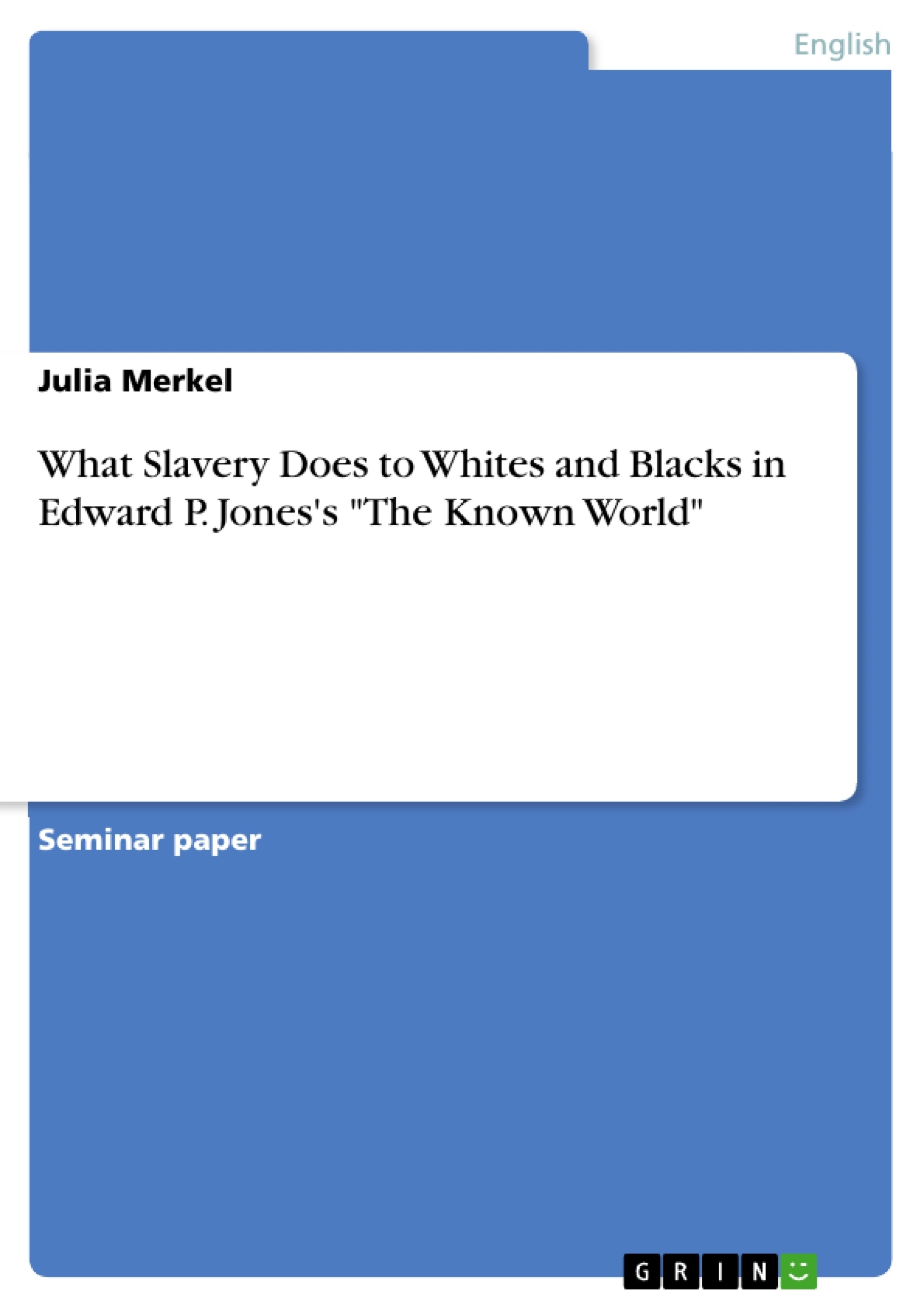Der Roman "The Known World" ist der einzige Roman von Pulitzer Preisträger Edward P. Jones, und trotzdem war er ein großer Erfolg. Er hat in der amerikanschen Gesellschaft eine erneute Diskussion losgetreten über die wenig bekannte historische Tatsache der schwarzen Sklavenhalter in den Südstaaten des 19. Jahrhunderts. Es wird die moralische und soziale Komponente des Phänomens, wie es im Roman dagestellt wird, untersucht. Ist die Sklaverei vielleicht unter einer dünnen Oberfläche farbenblind? Welche Umstände brachten Afro-Amerikaner dazu Sklaven zu halten? Welche Auswirkungen hatte diese Form der Sklaverei und unterschied sie sich überhaupt von der von Weißen ausgeübten Form? Die Arbeit zeigt anhand der Beispiele in "The Known World", dass Sklaverei in seinen Auswirkungen keine Unterschiede macht, und in seiner inhumanen zerstörerischen Kraft alle sozialen Strukturen vernichtet und in der Tat farbenblind ist.
Inhaltsverzeichnis (Table of Contents)
- Introduction: Color-blind Slavery.
- What Slavery does to Whites
- White Slaveholders
- Non-slaveholding Whites.
- White Slaves.
- The Slave-Slaveholder Relationship.
- What Slavery does to Blacks
- Black Slaveholders
- Non-slaveholding Blacks.
- Black Slaves
- Forms of Resistance
- The Effects on the Family Structure
- The Psychological Effects: Ruin for Anybody, Black or White.
- Conclusion: The Permeation of Every Part of Life.
Zielsetzung und Themenschwerpunkte (Objectives and Key Themes)
This paper analyzes the impact of slavery on both white and black characters in Edward P. Jones's novel The Known World, focusing on the complexities of the slave-master relationship and the pervasiveness of slavery in the characters' lives. The paper explores the ways in which the institution of slavery shapes individual identities, social structures, and psychological development. It aims to demonstrate that slavery, despite its inherent racism, leaves a profound and lasting mark on all individuals involved, regardless of their race.
- The impact of slavery on the psychological and social development of both white and black characters.
- The complexities of the slave-master relationship and the moral dilemmas it presents.
- The existence of black slaveholders and its implications for understanding the institution of slavery.
- The ways in which slavery permeates all aspects of life in the novel's setting, shaping the characters' relationships, attitudes, and values.
- The colorblindness of slavery's effects, demonstrating how the institution leaves a lasting mark on both those who own slaves and those who are enslaved.
Zusammenfassung der Kapitel (Chapter Summaries)
The paper begins by introducing the novel The Known World and highlighting the unique perspective it offers on slavery, particularly the phenomenon of black slaveholders. The first chapter delves into the experiences of white slaveholders in the novel, examining their attitudes towards their slaves and the institution of slavery. The chapter explores the conflicting emotions and behaviors of these characters, highlighting the ways in which the racist system of slavery impacts their personal lives and relationships.
The second chapter shifts the focus to the experiences of black characters in the novel, examining the diverse ways in which they are affected by slavery. The chapter analyzes the experiences of both black slaveholders and non-slaveholding blacks, highlighting the complexities of their lives and the challenges they face within the institution of slavery. It also investigates the experiences of enslaved blacks, exploring their forms of resistance, the effects on family structure, and the psychological toll of living under the constant threat of oppression.
The third chapter explores the broader psychological effects of slavery on all individuals involved, regardless of their race. It argues that slavery leaves a lasting mark on both the oppressors and the oppressed, impacting their mental and emotional well-being, and shaping their individual identities.
Schlüsselwörter (Keywords)
The key concepts and themes explored in this paper include slavery, racism, the slave-master relationship, black slaveholders, psychological effects of slavery, social structures, personal development, The Known World, Edward P. Jones, and the impact of historical context on literary works.
- Citar trabajo
- Julia Merkel (Autor), 2006, What Slavery Does to Whites and Blacks in Edward P. Jones's "The Known World", Múnich, GRIN Verlag, https://www.grin.com/document/63381



